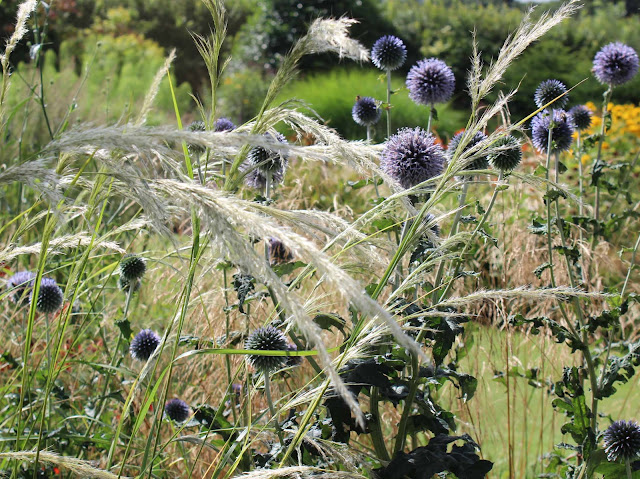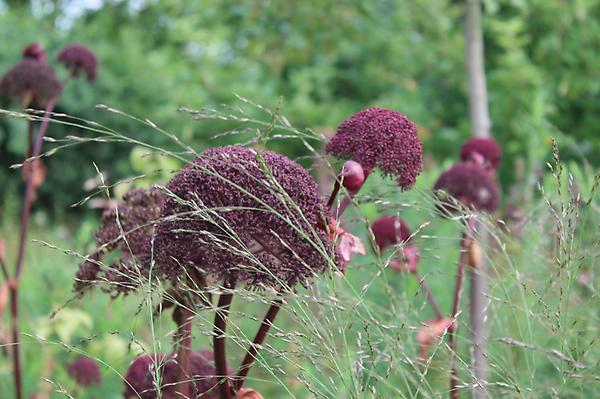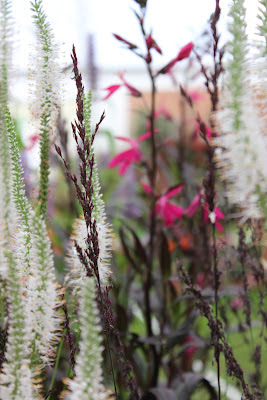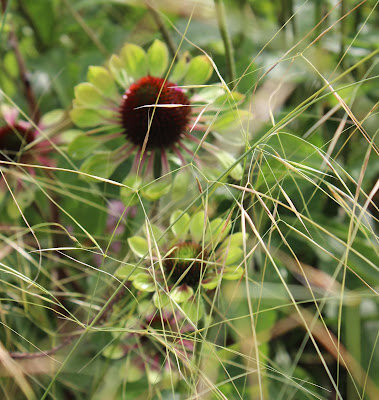Grasses make gardeners nervous. If they are planted at all the chances are they will be corralled into a separate zone on their own, as they were in this garden when I first took it over. The garden had wide herbaceous borders, a scree bed, shrub borders, mixed borders and an orchard. But the only visible grass in these areas was mown lawn. All of the flowering ornamental grasses were contained within an area entirely enclosed by six foot hedges, as if they might otherwise escape and wreak havoc amongst the flower beds, like so many unruly children.
 |
| Stipa pseudoichu with Echinops ritro |
Yes, some grasses do self seed and it’s as well to know which do, and which don’t as Anne Wareham discovered to her cost. But ironically all of the grasses contained within this green prison were models of self-restraint, failing to produce so much as a single offspring between them.
When grasses are allowed into the main garden they may then be placed in island beds, isolated by a barrier of lawn and expected to perform alone. Poor Stipa gigantea, condemned forever to the solitary confinement much more deservedly dished out to the irredeemably dreadful Pampas grass.
 |
| Angelica gigas with Molinia caerulea ‘Transparent’ |
Among the gardeners who do ‘get’ grasses, the prevailing presumption is that they must adopt the so-called prairie style for which they require half an acre. So pervasive have the words ‘prairie planting’ become (usually accompanied by the hallowed name of Piet Oudorf), that any hint of a grass in my otherwise floriferous borders ensures that visitors will use the word prairie when describing them. One clump of Deschampsia between two large clumps of daylilies does not a prairie make, but I have largely given up arguing about it.
So, how else might you use perennial grasses in mixed borders?
 The beginnings of a revelation for me came at Tatton Show in 2010. I spotted a beautiful, fine-stemmed, bronze/black grass on one of the show gardens, its delicate dark flowers at my waist height. Tatton Show is in late July – and that’s a clue to the most important characteristic about what has become one of my favourite grasses, Molinia caerulea ‘Edith Dudszus’ – it is summer flowering.
The beginnings of a revelation for me came at Tatton Show in 2010. I spotted a beautiful, fine-stemmed, bronze/black grass on one of the show gardens, its delicate dark flowers at my waist height. Tatton Show is in late July – and that’s a clue to the most important characteristic about what has become one of my favourite grasses, Molinia caerulea ‘Edith Dudszus’ – it is summer flowering.
(Fine grasses are notoriously difficult to photograph. Much of the beauty comes from their movement. But here is ‘Edith’ against a white Veronicastrum with Lobelia ‘Russian Princess’ behind it on my stand at Southport Flower Show this year. Hopefully this does it some justice)
And once you start noticing summer flowering grasses, they seem to appear everywhere. Miscanthus is the big name in ornamental grasses, but in my view probably the least useful, especially in domestic gardens. I’m writing this on September 11th and Miscanthus sinensis ‘Undine’, the earliest to flower here, has just opened its first flower heads. Yet I’ve been enjoying some of my grasses in flower since the end of June.
What difference does it make when grasses flower? Well, apart from the fact that it’s nice to see them in summer sunshine, it means you can pair them with flowering perennials because they are both at their peak of beauty at the same time.
Bingo. Partnership planting.
I think the pairing works best when one grass is planted with one perennial. I can’t give you a formula. I can only say that when you put them together, they must offer something to one another. Often a truly beautiful flower becomes even more interesting once it is partly veiled (see the Echinacea ‘Green Envy’ below). Sometimes the flower acts as a solid backdrop against which the form of the grass becomes more apparent (as in the Angelica/Molinia combination above). Increasingly for me it’s about pairing something static (like the Echinops, top) with something perpetually moving, like the shimmering, silver Stipa pseudoichu.
 |
| Echinacea ‘Green Envy’ and Stipa capillata |
This is very much a work in progress for me – but it’s giving me a great deal of pleasure experimenting. It’s also going to create a terrifying amount of work as I plan to replant half the garden to make my favourite pairings happen. But it’s going to be a joy.
 |
| Echinacea Magnus? with Deschampsia ‘Bronzeschleier’ at its blond stage |


 The beginnings of a revelation for me came at Tatton Show in 2010. I spotted a beautiful, fine-stemmed, bronze/black grass on one of the show gardens, its delicate dark flowers at my waist height. Tatton Show is in late July – and that’s a clue to the most important characteristic about what has become one of my favourite grasses, Molinia caerulea ‘Edith Dudszus’ – it is summer flowering.
The beginnings of a revelation for me came at Tatton Show in 2010. I spotted a beautiful, fine-stemmed, bronze/black grass on one of the show gardens, its delicate dark flowers at my waist height. Tatton Show is in late July – and that’s a clue to the most important characteristic about what has become one of my favourite grasses, Molinia caerulea ‘Edith Dudszus’ – it is summer flowering.


9 Responses to “Perennial grasses, perfect partnerships”
Great post Sue, I love Agastache 'Black Adder' or Salvia 'Indigo Spires' with Calamagrostis brachytricha.
Hello Brian, long time no hear from! I like those combinations – Agastache 'Black Adder' just scrapes through the winter here, but A. 'Liquorice Blue' does really well – got quite a lot of it in the garden. I've planted Calamagrostis brachytricha in blocks between Achillea in the new canal border but it's not quite right. Will try it
Some nice photos. Glad to see your Blog today. Hope to return. Jack
Wonderful post! Found you on Jean's Garden-Garden Blog of the Month. I too love to use grasses in the garden and depend on them in the fall. I must start to pair them with the appropriate perennials as you suggest. I love the pairing of static (echinops) and dynamic (stipa)-just beautiful!
Sue, I really enjoyed this post. I'm afraid I've been one of those gardeners who doesn't "get" grasses, so this helps me to think about them differently. Thanks. I've just recently discovered your blog at Blotanical, and I've become a fan. I do a monthly "Garden Blogs of the Month" feature on my blog, Jean's Garden, where I review and recommend garden blogs that I think my readers would enjoy. Your blog is one of three that I am highlighting this month. My post reviewing your blog just went up, and your blog will be featured on my sidebar throughout the month.
A BRAND NEW site for Garden Blogs
http://www.bloomingblogs.com
Please join up – You will be one of the first.
The first 25 NEW Members get 50 Bonus Points.
I have very slowly moved from a real prejudice against grasses to an almost reluctant pleasure in them. At the moment I am mulling about the idea of a swathe of stipa and molinia giving way to a second attempt at perennial meadow. Any suggestions as to which ones (or other ones I haven't thought of!) very gratefully received!
This is something new to learn about grasses! Thanks to your blog – a very good source of information.
Beautiful pictures! I agree pairing works best when one grass is planted with one perennial…like-Long-blooming perennials, like cone flowers, are perfect partners for showy fall grasses.